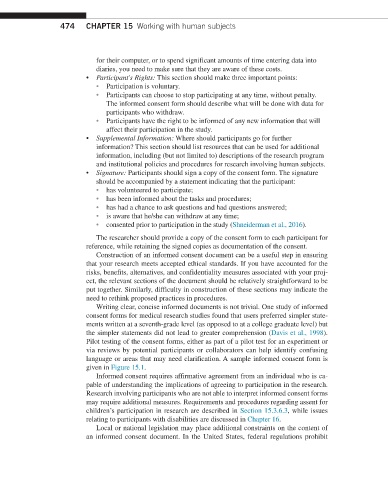Page 482 -
P. 482
474 CHAPTER 15 Working with human subjects
for their computer, or to spend significant amounts of time entering data into
diaries, you need to make sure that they are aware of these costs.
• Participant's Rights: This section should make three important points:
• Participation is voluntary.
• Participants can choose to stop participating at any time, without penalty.
The informed consent form should describe what will be done with data for
participants who withdraw.
• Participants have the right to be informed of any new information that will
affect their participation in the study.
• Supplemental Information: Where should participants go for further
information? This section should list resources that can be used for additional
information, including (but not limited to) descriptions of the research program
and institutional policies and procedures for research involving human subjects.
• Signature: Participants should sign a copy of the consent form. The signature
should be accompanied by a statement indicating that the participant:
• has volunteered to participate;
• has been informed about the tasks and procedures;
• has had a chance to ask questions and had questions answered;
• is aware that he/she can withdraw at any time;
• consented prior to participation in the study (Shneiderman et al., 2016).
The researcher should provide a copy of the consent form to each participant for
reference, while retaining the signed copies as documentation of the consent.
Construction of an informed consent document can be a useful step in ensuring
that your research meets accepted ethical standards. If you have accounted for the
risks, benefits, alternatives, and confidentiality measures associated with your proj-
ect, the relevant sections of the document should be relatively straightforward to be
put together. Similarly, difficulty in construction of these sections may indicate the
need to rethink proposed practices in procedures.
Writing clear, concise informed documents is not trivial. One study of informed
consent forms for medical research studies found that users preferred simpler state-
ments written at a seventh-grade level (as opposed to at a college graduate level) but
the simpler statements did not lead to greater comprehension (Davis et al., 1998).
Pilot testing of the consent forms, either as part of a pilot test for an experiment or
via reviews by potential participants or collaborators can help identify confusing
language or areas that may need clarification. A sample informed consent form is
given in Figure 15.1.
Informed consent requires affirmative agreement from an individual who is ca-
pable of understanding the implications of agreeing to participation in the research.
Research involving participants who are not able to interpret informed consent forms
may require additional measures. Requirements and procedures regarding assent for
children’s participation in research are described in Section 15.3.6.3, while issues
relating to participants with disabilities are discussed in Chapter 16.
Local or national legislation may place additional constraints on the content of
an informed consent document. In the United States, federal regulations prohibit

